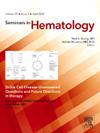第12届Waldenström巨球蛋白血症国际研讨会第六共识小组报告:转化型Waldenström巨球蛋白血症的诊断和管理。
IF 4.1
3区 医学
Q1 HEMATOLOGY
引用次数: 0
摘要
组织学转化(HT)在Waldenström的巨球蛋白血症(WM)是一种罕见的并发症,尽管越来越多的文献在过去几年,没有共识的建议存在。召开了第12届Waldenström大球蛋白血症国际研讨会(iwm -12)的第六共识小组(CP6),以审查目前关于转化性白细胞白血病的数据,并就其诊断和管理提出建议。iwm -12 CP6的主要建议包括:(1)在疑似HT的情况下,组织活检是诊断的金标准;(2)初始检查应包括18FDG-PET/CT,用于评估疾病程度,对于临床怀疑的患者或高危患者(CNS-IPI,多发性和/或特异性结外受累),脑脊液检查和脑MRI;(3)标准剂量化学免疫治疗(CIT),如R-CHOP(利妥昔单抗、环磷酰胺、阿霉素、长春新碱和泼尼松)或R-CHP + polatuzumab vedotin是首选的一线方案;(4)根据新生弥漫性大b细胞淋巴瘤(DLBCL)指南,可考虑用自体干细胞移植(SCT)预防和巩固中枢神经系统;(5)根据国际DLBCL指南和局部可及性,应在复发/难治性情况下使用t细胞结合疗法(CAR - t细胞,双特异性抗体)。未解决的关键问题包括TP53异常和CXCR4突变对HT风险的作用,WM和HT之间克隆关系的预后作用,最佳一线治疗(在CIT中添加新药物,剂量强化CIT,自体SCT巩固),以及t细胞参与治疗的顺序。国际合作以及对临床试验的考虑和纳入对于在罕见患者群体中解决这些问题至关重要。本文章由计算机程序翻译,如有差异,请以英文原文为准。
Report of Consensus Panel 6 from the 12th International Workshop on Waldenstrom's Macroglobulinemia on Diagnosis and Management of Transformed Waldenstrom's Macroglobulinemia
Histological transformation (HT) in Waldenström’s macroglobulinemia (WM) is a rare complication and despite growing literature in the last years, no consensus recommendations exist. Consensus Panel 6 (CP6) of the 12th International Workshop on Waldenström’s Macroglobulinemia (IWWM-12) was convened to review the current data on transformed WM and make recommendations on its diagnosis and management. The key recommendations from IWWM-12 CP6 included: (1) in case of suspected HT, tissue biopsy is the gold standard for diagnosis; (2) the initial work-up should comprise 18FDG-PET/CT for the evaluation of disease extent and, for patients with clinical suspicion or for high-risk patients (CNS-IPI, multiple and/or specific extranodal involvements), cerebrospinal fluid examination and brain MRI; (3) standard dose chemoimmunotherapy (CIT) such as R-CHOP (rituximab, cyclophosphamide, doxorubicine, vincristine and prednisone) or R-CHP + polatuzumab vedotin are the preferred front-line regimen; (4) CNS prophylaxis and consolidation with autologous stem cell transplantation (SCT) can be considered according to de novo diffuse large B-cell lymphoma (DLBCL) guidelines; (5) T-cell-engaging therapies (CAR T-cells, bispecific antibodies) should be used in the relapse/refractory setting according to international guidelines for DLBCL and local access to these therapies. Key unanswered questions include the role of TP53 abnormalities and CXCR4 mutations on the risk of HT, the prognostic role of clonal relationship between WM and HT, the optimal front-line therapy (addition of novel agents to CIT, dose-intensive CIT, consolidation with autologous SCT), and the sequence of T-cell-engaging therapies. International collaboration and consideration of and inclusion in clinical trials is critical to address these issues in a rare patient population.
求助全文
通过发布文献求助,成功后即可免费获取论文全文。
去求助
来源期刊

Seminars in hematology
医学-血液学
CiteScore
6.20
自引率
2.80%
发文量
30
审稿时长
35 days
期刊介绍:
Seminars in Hematology aims to present subjects of current importance in clinical hematology, including related areas of oncology, hematopathology, and blood banking. The journal''s unique issue structure allows for a multi-faceted overview of a single topic via a curated selection of review articles, while also offering a variety of articles that present dynamic and front-line material immediately influencing the field. Seminars in Hematology is devoted to making the important and current work accessible, comprehensible, and valuable to the practicing physician, young investigator, clinical practitioners, and internists/paediatricians with strong interests in blood diseases. Seminars in Hematology publishes original research, reviews, short communications and mini- reviews.
 求助内容:
求助内容: 应助结果提醒方式:
应助结果提醒方式:


